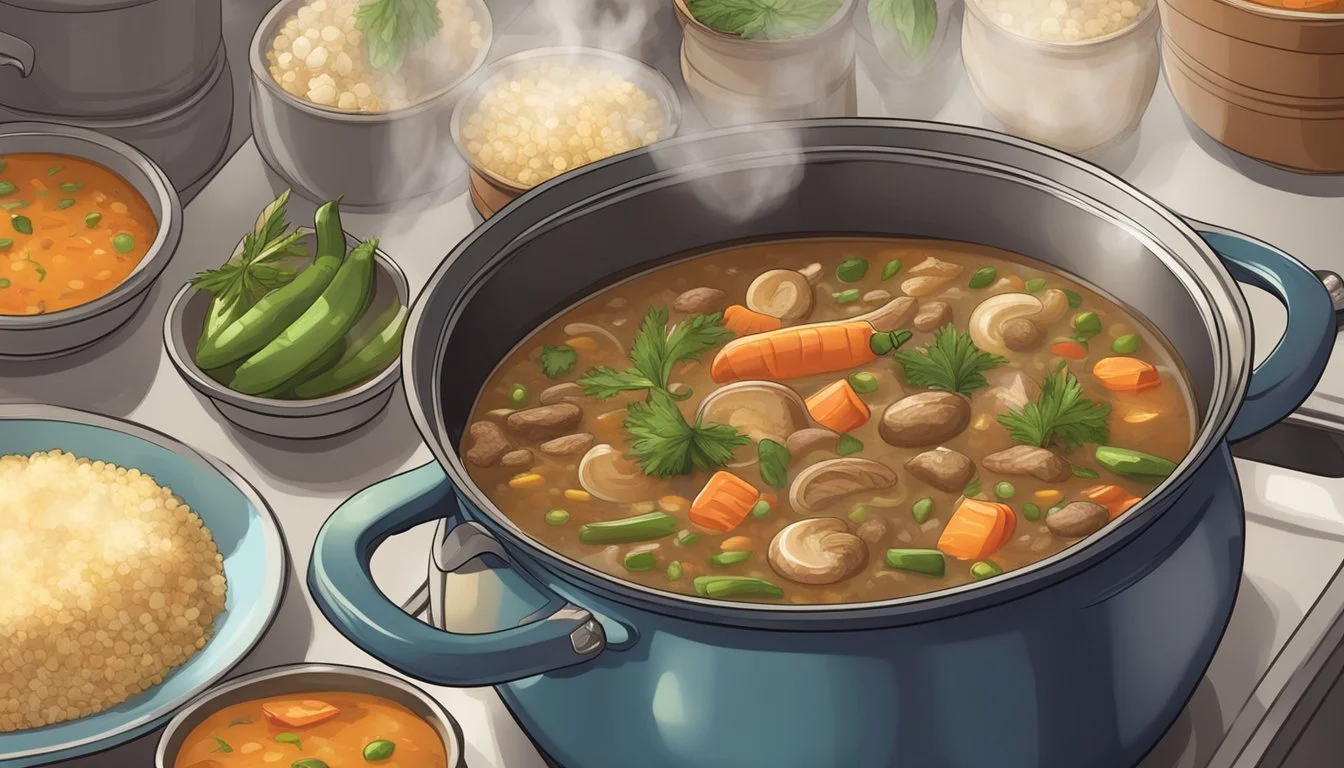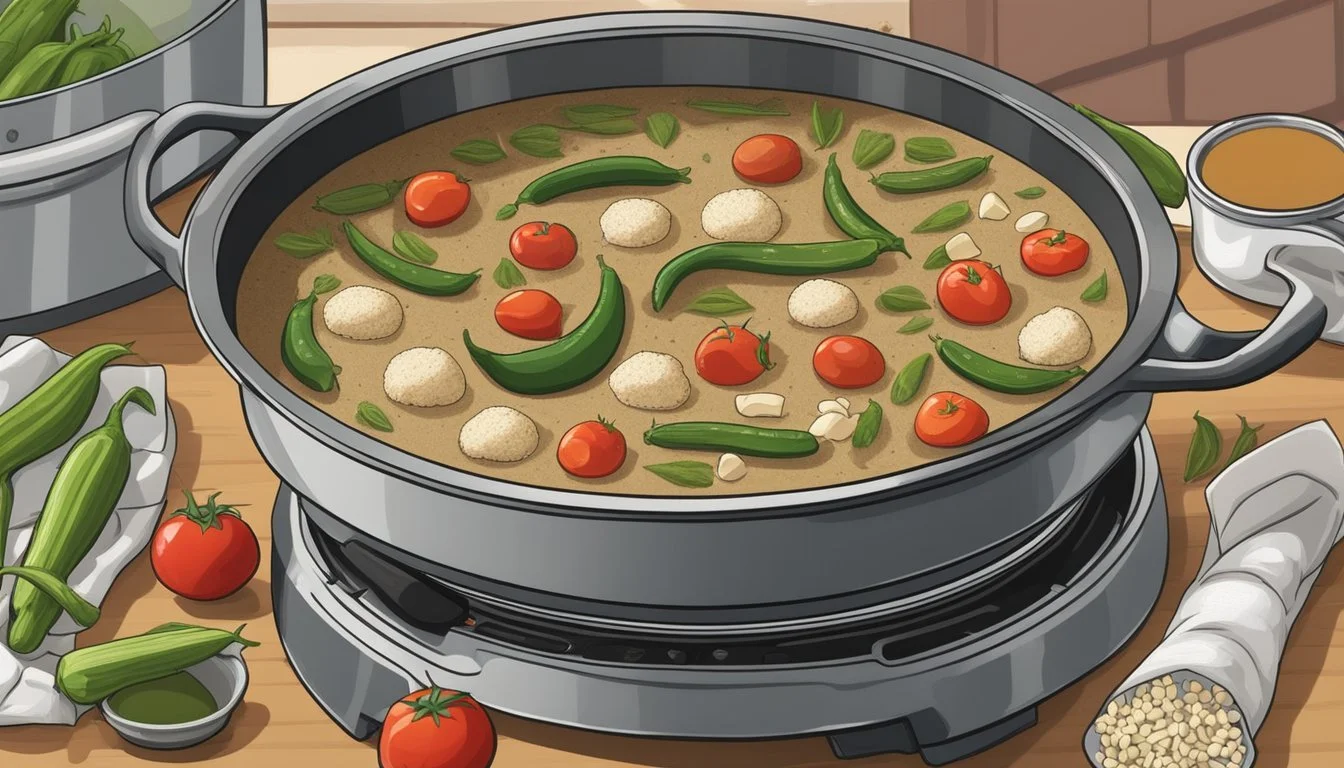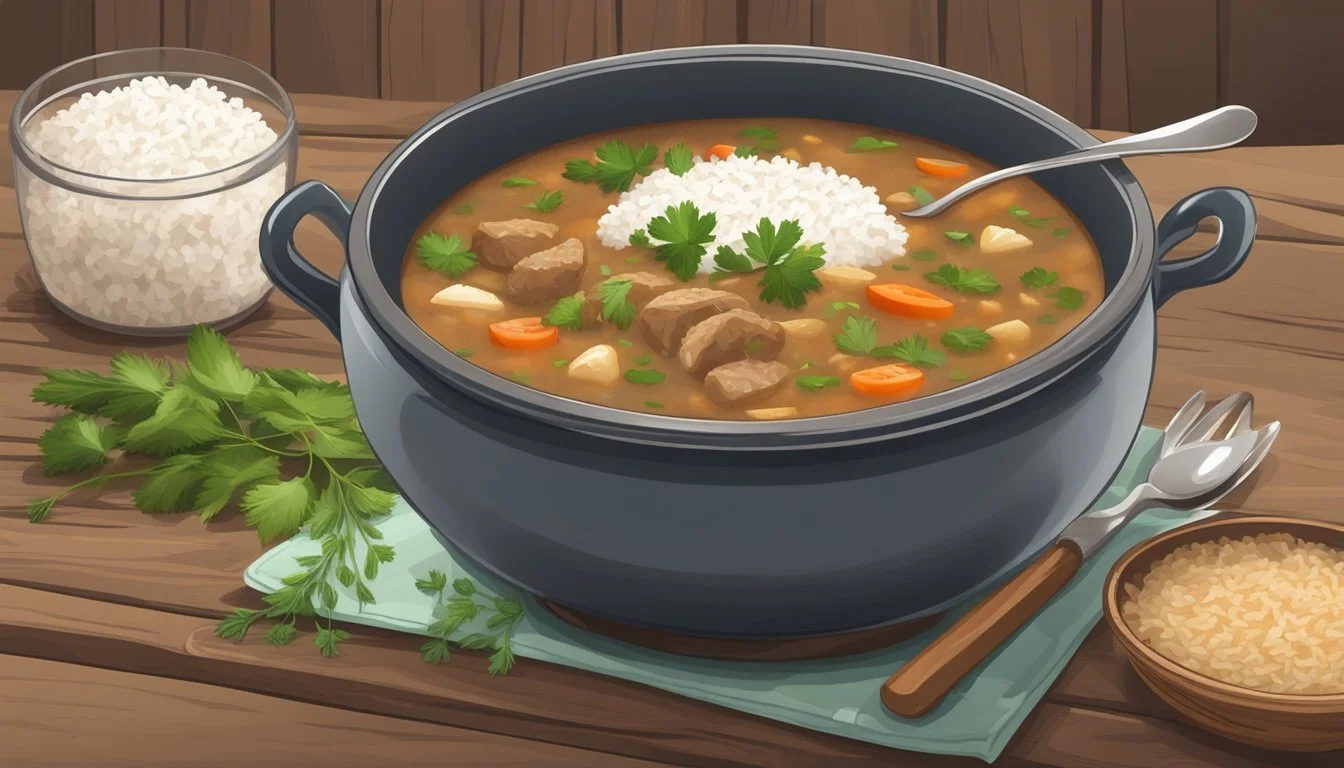How Long Does Gluten-Free Gumbo Last?
Storage Tips and Shelf Life Explained
Balancing the rich heritage of Louisiana cuisine with modern dietary needs, gluten-free gumbo offers a flavorful twist on a classic comfort food. Known for its robust and hearty ingredients, this dish often includes shrimp, chicken, and andouille sausage, bringing together a delightful blend of New Orleans flavors. Ensuring that your gluten-free gumbo stays fresh and safe to eat is key for enjoying its warm, comforting essence.
Gluten-free gumbo can last up to 3-4 days in the refrigerator if stored properly in an airtight container. The quality of ingredients, especially the freshness of the shrimp and chicken, plays a crucial role in determining its shelf life. Frozen gumbo can extend its shelf life significantly, maintaining its taste and texture for up to 3 months in the freezer.
Proper storage and ingredient quality are essential to prevent spoilage. Using fresh meats and proper thawing methods can help maximize the longevity of your gluten-free gumbo, making each serving as delicious as the first.
Understanding Gluten-Free Gumbo
Gluten-free gumbo maintains the delicious flavors and textures of traditional gumbo while ensuring it is safe for those with gluten sensitivities. This includes key components like seafood, chicken, and sausages, as well as gluten-free alternatives for traditional ingredients.
Components of Traditional Gumbo
Traditional gumbo is a rich stew originating from Louisiana. The main ingredients typically include seafood such as shrimp, chicken, and andouille sausage. A significant element is the use of a roux made from flour and fat, which thickens the dish.
Another essential component is the trinity of onions, bell peppers, and celery. Other common ingredients are tomatoes, okra, and various Cajun spices, which add to the complexity of the dish. Additionally, gumbo is often served over white rice and garnished with green onions.
Necessity of Gluten-Free Ingredients
For those needing gluten-free gumbo, the primary concern is altering the roux. Traditional roux relies on wheat flour, which contains gluten. Alternatives like gluten-free all-purpose flour, cassava flour, or 1:1 gluten-free flour must be used.
These substitutes ensure that the gumbo remains thick and flavorful without the gluten. Ensuring that all other ingredients, such as sausages, spices, and broth, are also gluten-free is critical to prevent cross-contamination.
The result is a dish that retains the rich, hearty characteristics of traditional gumbo while being safe for those with gluten intolerance or celiac disease.
Essential Ingredients and Substitutes
Preparing a gluten-free gumbo involves selecting the right meats, vegetables, and flavor enhancers. Various substitutes can be used to accommodate dietary needs without compromising on taste.
Meat and Seafood Selection
Chicken and Andouille Sausage are staples in gumbo. Opt for chicken thighs or chicken breast. Shrimp, crab meat, and fish can be added to enhance the flavor.
For a spicy kick, Andouille sausage is preferred, but for a milder option, use a gluten-free variety or even turkey sausage. For vegetarians, omit meat entirely or add hearty veggies like mushrooms or zucchini.
Vegetable Choices
Traditional gumbo includes onion, bell peppers (green, red, and yellow), garlic, celery, and okra. These vegetables are essential for the dish's depth of flavor.
Tomatoes can add a touch of sweetness. For a twist, use cauliflower rice instead of traditional white or brown rice to keep it lower in carbs.
Chopped green onions and fresh parsley are excellent garnishes that add both color and freshness.
Flavor Enhancers
Creating a gluten-free roux using gluten-free flour and vegetable, olive, avocado, or coconut oil is critical for thickening the gumbo.
Chicken broth is the base, but vegetable broth can be used as a substitute. Seasoning is vital; include Cajun or Creole seasoning, bay leaves, thyme, salt, and pepper.
A few dashes of hot sauce and Worcestershire sauce can elevate the taste. Adjust the seasoning to personal preference, making sure to balance the heat and savoriness.
Creating the Perfect Gluten-Free Roux
A gluten-free roux is essential for a smooth and flavorful gumbo. It requires specific ingredients and techniques to ensure the right texture and taste.
Step-by-Step Roux Technique
Start by heating oil in a skillet over medium-low heat. Common choices include vegetable, canola, or olive oil.
Add gluten-free all-purpose flour gradually. Use equal parts of oil and flour for a balanced texture (e.g., ½ cup oil, ½ cup flour).
Stir continuously with a wooden spoon in a figure-eight motion. This helps to evenly incorporate the flour and prevent burning. After 2-3 minutes, the roux will begin to thicken, then it will gradually thin out again.
Continue stirring until the mixture reaches a golden brown color. For a darker roux typical in Cajun cuisine, continue until it turns copper brown, about 15-25 minutes.
Troubleshooting Common Roux Issues
Lumpy Roux: If lumps form, it usually means the flour was added too quickly or not stirred enough. Gradually adding the flour and constant stirring are key to preventing this.
Burning: If the roux starts to scorch, the heat is too high. Reduce the heat and keep stirring. If the burnt taste is noticeable, it’s best to start over for the best flavor.
Too Thin or Thick: Consistency issues can be resolved by adjusting the oil or flour. If too thick, add a bit more oil. If too thin, add a little more flour, stirring well.
A well-made gluten-free roux adds depth and richness to gumbo, enhancing each delicious bite without compromising texture or flavor.
Storing and Preserving Gumbo
When storing gluten-free gumbo, it's crucial to follow specific guidelines to maintain its freshness and flavor. The key points to consider are proper refrigeration for short-term storage and effective freezing methods for long-term preservation.
Short-Term Storage Guidelines
For short-term storage, gluten-free gumbo should be refrigerated immediately after it cools to room temperature. Transfer the gumbo to an airtight container to prevent contamination and moisture buildup. Gumbo can last in the refrigerator for about 4-5 days when stored correctly. Make sure the refrigerator temperature is consistently at or below 40°F (4°C) to keep the gumbo fresh and safe to eat.
Steps for Short-Term Storage:
Allow gumbo to cool to room temperature.
Transfer to an airtight container.
Store in the refrigerator at or below 40°F (4°C).
Monitoring the gumbo during storage is important. If you notice any off smells, unusual colors, or changes in texture, it's best to discard the gumbo to avoid any health risks.
Long-Term Freezing Techniques
Freezing gluten-free gumbo is an effective method for long-term storage. To freeze gumbo, ensure it has cooled to room temperature before transferring it to freezer-safe containers. Leave about an inch of space at the top of the container to allow for expansion. Label the containers with the date of freezing to keep track of its shelf life.
Freezing Steps:
Cool gumbo to room temperature.
Transfer to freezer-safe containers, leaving space at the top.
Label with the freezing date.
Store in the freezer at 0°F (-18°C) or lower.
Gumbo can be stored in the freezer for up to 3 months without significant loss of flavor or texture. When ready to consume, thaw the gumbo in the refrigerator overnight before reheating. Avoid microwaving directly from frozen to maintain the best quality.
Serving Suggestions and Accompaniments
Pairing gluten-free gumbo with the right sides enhances its flavors and makes for a more satisfying meal. This section covers classic and innovative gluten-free options that complement the hearty dish perfectly.
Classic Pairings
A traditional pairing for gumbo is rice, often white rice. It absorbs the robust flavors of the gumbo, creating a balanced meal. Brown rice can also be a great alternative, adding a nutty flavor and extra nutrients.
Gluten-free cornbread is another favorite. It offers a slightly sweet contrast to the savory gumbo and is excellent for soaking up the sauce.
Potato salad is a well-loved side as well. Served cold, it provides a refreshing counterpoint to the warm gumbo, enhancing the dining experience.
Innovative Gluten-Free Options
For those looking to explore beyond the classics, consider serving gumbo with cauliflower rice. This low-carb alternative to regular rice maintains a similar texture without compromising on flavor.
Roasted vegetables such as mushrooms or bell peppers can be tossed into the gumbo or served on the side. They add depth to the dish and cater to a gluten-free diet.
Gluten-free dairy-free mashed potatoes are a comforting side. They pair well with gumbo’s rich broth and provide a creamy texture that complements the dish.
By offering these various sides and accompaniments, one can cater to both traditional tastes and modern dietary preferences, ensuring a delightful meal for everyone.
Special Considerations for Dietary Restrictions
Making gluten-free gumbo that caters to various dietary restrictions requires careful selection of ingredients. One key focus is modifying traditional recipes to suit vegetarian preferences while maintaining the dish's robust flavor profile.
Making Vegetarian Gumbo Variants
Vegetarian gumbo replaces meat with plant-based alternatives to align with vegetarian diets. Use vegetable broth instead of chicken broth to start. Add a diverse mix of vegetables such as carrots, bell peppers, celery, and okra for texture and nutrition. Chickpeas or tofu can be added as protein sources.
Enhance the seasoning with Cajun spices. Avoid Worcestershire sauce if it contains anchovies, and opt for vegetarian substitutes. This ensures the gumbo remains flavorful without compromising dietary guidelines.
Cultural Significance and History
Gumbo stands as a culinary symbol shedding light on the rich cultural tapestry of Louisiana, blending traditions and ingredients from various cultures over centuries.
Gumbo in Louisiana Culture
Gumbo represents more than just a dish in Louisiana; it symbolizes the region's cultural amalgamation. The dish plays a key role in family gatherings and communal events.
French and Spanish settlers significantly influenced the cooking techniques and ingredients in gumbo. The inclusion of okra can be traced back to the contributions of enslaved Africans. Various Native American tribes also added to the recipe by incorporating locally available ingredients.
New Orleans is often highlighted for its distinctive versions of gumbo, which blend seamlessly into the fabric of its Creole and Cajun communities. This melting pot of cultures makes gumbo a microcosm of the area’s broader cultural and historical narrative.
Evolution of Gumbo Cooking Styles
The styles and ingredients of gumbo have evolved, reflecting the diverse cultures that shape Louisiana cuisine. Initially, traditional recipes often featured okra as a thickening agent, a practice rooted in West African traditions.
With time, the roux—an element borrowed from French cooking techniques—became a staple in gumbo preparation. A roux involves slowly cooking flour and fat until it reaches a rich brown hue.
Cajun and Creole versions of gumbo reflect regional variations. Cajun gumbo often emphasizes meats like chicken and sausage, while Creole gumbo incorporates a variety of seafood. Despite these variations, the dish has maintained its fundamental essence while evolving to incorporate new elements and cater to different palates.
Each evolution in the cooking style demonstrates gumbo's deep-rooted adaptability and historical significance.









